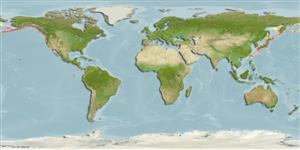Environment: milieu / climate zone / depth range / distribution range
Ecologia
marino batidemersale; distribuzione batimetrica 10 - 338 m (Ref. 51661). Temperate
Eastern Pacific: southeastern Bering Sea and Unimak Pass, eastern Aleutian Islands to Crescent City and San Simeon Point, central California, USA.
Size / Peso / Age
Maturity: Lm ? range ? - ? cm
Max length : 18.0 cm TL maschio/sesso non determinato; (Ref. 2850)
Short description
Chiavi di identificazione | Morfologia | Morfometria
Spine dorsali (totale) : 0; Raggi dorsali molli (totale) : 33 - 35; Spine anali: 0; Raggi anali molli: 27 - 29. Caudal narrow, rounded. Pectorals with a rounded upper part; lower part with longer, exserted rays on the ventral edge.
Occurs near shore and to 388 m depth (Ref.2850). Feeds on shrimps and other crustaceans (Ref. 6885).
Life cycle and mating behavior
Maturità | Riproduzione | Deposizione | Uova | Fecundity | Larve
Chernova, N.V., 2008. Systematics and phylogeny of fish of the genus Liparis (Liparidae, Scorpaeniformes). J. Ichthyol. 48(10):831-852. (Ref. 79981)
IUCN Red List Status (Ref. 130435: Version 2024-2)
Threat to humans
Harmless
Human uses
Pesca: di nessun interesse
Strumenti
Special reports
Download XML
Fonti Internet
Estimates based on models
Preferred temperature (Ref.
123201): 3.1 - 7.8, mean 4.8 °C (based on 34 cells).
Phylogenetic diversity index (Ref.
82804): PD
50 = 0.5000 [Uniqueness, from 0.5 = low to 2.0 = high].
Bayesian length-weight: a=0.01202 (0.00505 - 0.02860), b=3.05 (2.84 - 3.26), in cm total length, based on LWR estimates for this (Sub)family-body shape (Ref.
93245).
Trophic level (Ref.
69278): 3.6 ±0.55 se; based on food items.
Resilienza (Ref.
120179): Alto, tempo minimo di raddoppiamento della popolazione meno di 15 mesi (Preliminary K or Fecundity.).
Fishing Vulnerability (Ref.
59153): Low vulnerability (10 of 100).
